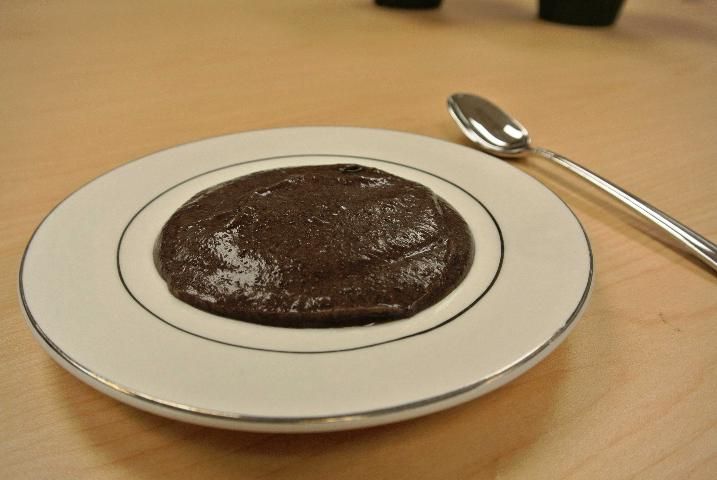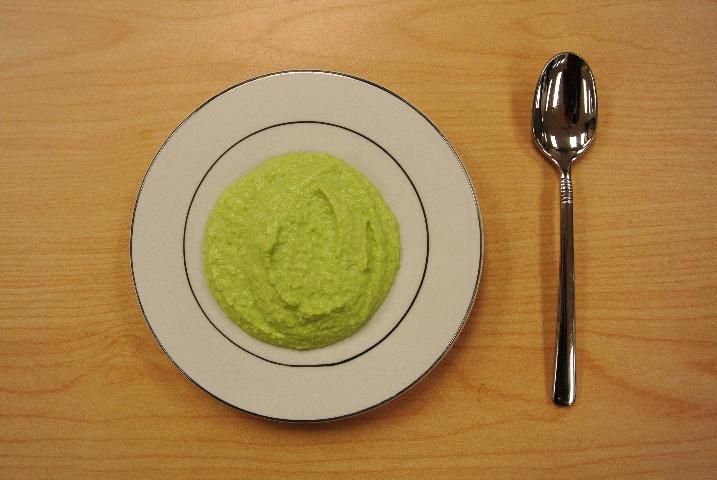Fiber is important for good health. Inadequate fiber intake may lead to constipation and other gastrointestinal complaints. Diets higher in fiber reduce the risk of heart disease, type 2 diabetes, and some forms of cancer (Dahl and Stewart 2015) and may be helpful in the treatment of some chronic diseases (Dahl et al. 2016). Although fiber is found in all plant foods, such as fruits, vegetables, beans, grains, nuts, and seeds, most people in the US do not consume enough fiber (Reicks et al. 2014). Recommended fiber intakes are shown in Table 1.

Credit: UF/IFAS photo
Do people with swallowing problems get enough fiber?
People with swallowing problems who require a puréed diet may not meet their recommended intake of fiber. Studies of long-term care residents show fiber intakes are low, ranging from 10 g to 16 g of fiber per day (Lengyel, Whiting, and Zello 2008; Fosnes, Lydersen, and Farup 2012; Volkert and Schrader 2013). Fiber intakes of those who consume puréed diets (Germain, Dufresne, and Gray-Donald 2006) are similar to that of the general US population (Reicks et al. 2014).
Many puréed foods naturally contain dietary fiber. Puréed beans, peas, and lentils are good sources of fiber. For example, a ¼-cup serving of hummus prepared from puréed chickpeas provides 2.5 g of fiber. Puréed fruits and vegetables are also sources of fiber, with ½-cup servings providing, on average, about 2 g of fiber. Cooking does not change the amount of fiber in foods; cooked and puréed vegetables contain the same amount of fiber as raw vegetables. Table 2 shows the fiber contents of some common puréed foods. Animal-sourced foods such as dairy, meats, fish, poultry, and eggs do not naturally contain fiber.
How is a high-fiber puréed diet achieved?
Puréed diets can be planned to achieve fiber recommendations by choosing higher-fiber puréed foods often. See Table 3 later in this document for an example of a high-fiber puréed menu. Alternatively, the fiber content of a puréed diet that is prepared at home or in a family or long-term care home can be increased by adding fiber ingredients.
A variety of fiber ingredients that can be added to puréed foods is available. Fiber ingredients can be soluble or insoluble. Soluble fibers dissolve in water. These fiber ingredients can be easily mixed into beverages, and most have little to no effect on taste. As puréed foods are high in water (see Puréed Food, Thickened Beverages and Water Needs), soluble fibers are easily added.
Examples of soluble fiber ingredients include:
- Chicory root fiber (also called inulin, oligofructose)
- Fructooligosaccharide
- Corn dextrin
- Hydrolyzed guar gum
- Soy fiber
- Sugar beet fiber
- Wheat dextrin
Insoluble fibers also can be added to some puréed foods, particularly purée-texture grains. For example, the fiber level in oatmeal porridge can be enhanced by adding fiber. Puréed meats and fish are other good choices for the addition of insoluble fiber, because the texture and flavor of the puréed meat and fish tend to mask the added fiber. Examples of insoluble fiber ingredients include:
- Bamboo fiber
- Cellulose
- Corn bran
- Cottonseed fiber
- Oat hull
- Pea hull fiber
- Rice bran
- Sugar cane fiber
- Wheat bran (finely ground)
Which fiber ingredients are best?
If prevention of constipation is the goal, insoluble fibers are the best choices. Insoluble fibers work to bulk the stool. Although many soluble fibers have been shown to have some effect on stool bulking, a much higher intake is required—bran or hull fibers bulk the stool much more than a soluble fiber would (Cummings 2001).
If a prebiotic effect is the goal, a soluble fiber such as chicory root fiber is best. Prebiotic fibers promote the growth of what are considered good bacteria in the colon and may enhance health and wellness (Roberfroid et al. 2010).
If the goal is lowering cholesterol and blood glucose, such as for individuals with diabetes, viscous soluble fibers are effective (Dikeman and Fahey 2006). These fibers, when added to water or when eaten, cause thickening. It is this viscosity or thickening that works best to lower cholesterol and blood glucose. However, these fibers, when added to a puréed food, will cause the food to become too thick (and too sticky) for safe swallowing and should not be used. An example of a viscous fiber is psyllium. Psyllium poses a serious risk of choking for those with swallowing disorders and is not recommended (NIH n.d.). Instead, a food such as oatmeal made from finely ground oats that naturally contains viscous fiber may be included in the puréed diet.
How much fiber should be added to puréed foods?
The addition of 10–15 g/day of fiber to a puréed diet would help those consuming the diet meet the fiber recommendation. However, adding as little as 4 g/day of fiber to a long-term care menu has been shown to improve bowel function, particularly in those with constipation (Dahl et al. 2003). Table 3 presents data for a high-fiber puréed menu, along with a lower-fiber puréed menu with and without fiber fortification.
The dietary fiber content of the high-fiber puréed menu (see below) is nearly 34 g, surpassing the recommendations for older men and women. The typical low-fiber puréed menu provides only 12 g of fiber. Substituting yogurt and pudding with similar commercial products containing added fiber, as well as fortifying three foods with an additional 7 g of insoluble fiber ingredients, brings the fiber level of the low-fiber menu up to nearly 25 g.

Credit: UF/IFAS photo
The type and amount of fiber added to a puréed food may impact a food's acceptability by changing its taste and texture. It is important to ensure that all foods fortified with fiber are taste-tested for acceptability. See https://edis.ifas.ufl.edu/fs206 for a guide to evaluating puréed foods for acceptability.
Where can I get more information?
Your local UF/IFAS Extension Family and Consumer Sciences (FCS) agent may have more written information and nutrition classes for you to attend. Also, a registered dietitian nutritionist (RDN) can provide reliable information to you.
References
Cummings, J. H. 2001. "The effect of dietary fiber on fecal weight and composition." In CRC Handbook of Dietary Fiber in Human Nutrition, edited by G. A. Spiller. 183–241. Boca Raton, FL: CRC Press.
Dahl, Wendy J., and M. L. Stewart. 2015. "Position of the Academy of Nutrition and Dietetics: Health implications of dietary fiber." Journal of the Academy of Nutrition and Dietetics 115 (11):1861–1870. doi: 10.1016/j.jand.2015.09.003.
Dahl, W. J., S. J. Whiting, A. Healey, G. A. Zello, and S. L. Hildebrandt. 2003. "Increased stool frequency occurs when finely processed pea hull fiber is added to usual foods consumed by elderly residents in long-term care." Journal of the American Dietetic Association 103 (9):1199–202. doi: 10.1053/jada.2003.50570.
Dikeman, C. L., and G. C. Fahey. 2006. "Viscosity as related to dietary fiber: A review." Critical Reviews in Food Science and Nutrition 46 (8):649–63. doi: 10.1080/10408390500511862.
Fosnes, G. S., S. Lydersen, and P. G. Farup. 2012. "Drugs and constipation in elderly in nursing homes: What is the relation?" Gastroenterology Research and Practice 2012:290231. doi: 10.1155/2012/290231.
Germain, I., T. Dufresne, and K. Gray-Donald. 2006. "A novel dysphagia diet improves the nutrient intake of institutionalized elders." Journal of the American Dietetic Association 106 (10):1614–23. doi: 10.1016/j.jada.2006.07.008.
Lengyel, C. O., S. J. Whiting, and G. A. Zello. 2008. "Nutrient inadequacies among elderly residents of long-term care facilities." Canadian Journal of Dietetic Practice and Research 69 (2):82–8. doi: 10.3148/69.2.2008.82.
National Institutes of Health (NIH). n.d. "DailyMed." Accessed on January 3, 2020. http://dailymed.nlm.nih.gov/dailymed/drugInfo.cfm?id=76906
Reicks, M., S. Jonnalagadda, A. M. Albertson, and N. Joshi. 2014. "Total dietary fiber intakes in the US population are related to whole grain consumption: Results from The National Health and Nutrition Examination Survey 2009 to 2010." Nutrition Research 34 (3): 226–234. doi: 10.1016/j.nutres.2014.01.002.
Roberfroid, M., G. R. Gibson, L. Hoyles, A. L. McCartney, R. Rastall, I. Rowland, D. Wolvers, et al. 2010. "Prebiotic effects: Metabolic and health benefits." British Journal of Nutrition 104 (Suppl 2): S1–63. doi: 10.1017/s0007114510003363.
Trumbo, P., S. Schlicker, A. A. Yates, and M. Poos. 2002. "Dietary reference intakes for energy, carbohydrate, fiber, fat, fatty acids, cholesterol, protein and amino acids." Journal of the American Dietetic Association 102 (11): 1621–1630.
United States Department of Agriculture (USDA). n.d.-c. "FoodData Central." Accessed on January 3, 2020. https://fdc.nal.usda.gov/
Volkert, D., and E. Schrader. 2013. "Dietary assessment methods for older persons: What is the best approach?" Current Opinion in Clinical Nutrition & Metabolic Care 16 (5):534–540. doi: 10.1097/MCO 0b013e328363c8d1.